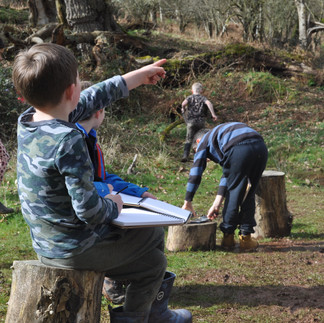Retracing the steps of the romantic poets at Alfoxton Park
- Jenna Creasey
- Apr 2, 2023
- 3 min read
As part of the project, 'In the Footsteps of the Romantic Poets', SPAEDA guided students on a journey to Alfoxton Park, an 18th-century country house with acres of land nestled in the breathtaking Quantock Hills. The students retraced the steps of William Wordsworth and his sister Dorothy Wordsworth who lived here for a time between July 1797 and June 1798, developing an appreciation for the Romantic Poets who found solace and inspiration in these very landscapes.
The school trip provided a platform for students to develop both their artistic and literary skills. They engaged in workshops, producing drawings, using the landscape around them as inspiration. They listened to poetry and came up with some of their own, responding to the woodland. They used textbooks to identify different flora and fauna and hunted down the silver wishing tree, writing down their own wishes and posting them gently in the hollow trunk. Some were big wishes some were small:
I wish that Turkey would win the World Cup
I wish that the tree would feel loved
I wish that mum would get better

"Happy, peaceful, chilled, like all my worries have turn to ashes, we shut our eyes and breathed in the woodland air, listening to the birds and our bodies before thanking William Wordsworth and heading home" - Quote from a student
The school trip to Alfoxton Park was a transformative experience for the students involved in the project. It provided them with an understanding of the intimate relationship between nature, art, and poetry. By immersing themselves in the captivating landscapes of the park, they were inspired to explore their artistic talents, deepen their knowledge of the Romantic era, and forge a lifelong connection with the beauty of the natural world.
"Alfoxden, January 20th 1798.—The green paths down the hill-sides are channels for streams. The young wheat is streaked by silver lines of water running between the ridges, the sheep are gathered together on the slopes. After the wet dark days, the country seems more populous. It peoples itself in the sunbeams. The garden, mimic of spring, is gay with flowers. The purple-starred hepatica spreads itself in the sun, and the clustering snow-drops put forth their white heads, at first upright, ribbed with green, and like a rosebud when completely opened, hanging their heads downwards, but slowly lengthening their slender stems. The slanting woods of an unvarying brown, showing the light through the thin net-work of their upper boughs. Upon the highest ridge of that round hill covered with planted oaks, the shafts of the trees show in the light like the columns of a ruin."
What is 'In the Footsteps of the Romantic Poets'?
Thanks to a grant from the National Lottery Heritage Fund, the Quantock Hills will provide a focus for pupils to explore, make and play outside as part of The Quantock Landscape Partnership Scheme led by The Quantock Hills Area of Outstanding Natural Beauty.
One of over 20 project strands 'In the Footsteps of the Romantic Poets' is the only QLPS project with a focus on formal education. It aims to help children and young people think creatively, taking inspiration from their surroundings; helping them understand and connect with their landscape and local heritage sites.
By getting outside and exploring the locality on their doorstep the project aims to inspire a sense of place and build links with the communities in and around the Quantock Hills that will last long after the project has ended.
‘We are delighted to be helping schools and cultural partners to work together on this ground-breaking project. Though walking and drawing in the landscape; using the natural objects found in the Hills and taking inspiration from the poets who once lived here, we hope to develop children and young peoples’ visual arts and creative writing skills; increase knowledge about their locality and the natural world and raise awareness of how it has, and will, change through time’ - Alice Crane - Spaeda Artistic Director


















